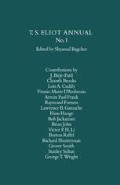Abstract
On 20 September 1920 Virginia Woolf wrote in her diary: ‘He [Eliot] wants to write a verse play in which the 4 characters of Sweeny [sic] act the parts’.1 Four years later, on 9 September 1924, T. S. Eliot informed Arnold Bennett that he had given up verse and wanted to write ‘a drama of modern life (furnished flat sort of people) in a rhythmic prose “perhaps with certain things in it accentuated by drum-beats”’.2 According to Grover Smith, Eliot drafted a version of the play, sent it to Bennett who returned it, and ‘on October 23 Eliot wrote to him again saying that he was reconstructing it in accordance with Bennett’s suggestion’.3 Apparently Grover Smith has had access to a correspondence between Eliot and Bennett, but he gives no sources. As is well-known there are certain allusions in Sweeney Agonistes to Fitzgerald’s The Great Gatsby. Hence the ‘Fragment of an Agon’ couldn’t have been ‘completed’ until near the end of 1925 when Eliot read the novel. This is more than a year after the conversation with Bennett. In 1926 ‘Fragment of a Prologue’ was published and the next year ‘Fragment of an Agon’. Carol Smith, like Grover Smith, thinks that the ‘sample fragments’ and ‘scenario’ ‘were probably completed two years earlier, for in October Eliot sent them both to Arnold Bennett with a request for criticism’.4
Access this chapter
Tax calculation will be finalised at checkout
Purchases are for personal use only
Preview
Unable to display preview. Download preview PDF.
Notes
Anne Olivier Bell and Andrew McNeillie (eds), The Diary of Virginia Woolf: Vol. II, 1920–24 (London: The Hogarth Press, 1978) p. 68.
Arnold Bennett, The Journals, selected and edited by Frank Swinnerton (Harmondsworth: Penguin, 1971) p. 483.
Grover Smith, T. S. Eliot’s Poetry and Plays: A Study in Sources and Meaning (Chicago and London: University of Chicago Press, 1967) pp. 113–14.
Carol H. Smith, T. S. Eliot’s Dramatic Theory and Practice. (Princeton, New Jersey: Princeton University Press, 1967) p. 51 (italics added).
Bernard Bergonzi, T. S. Eliot (London: Methuen, 1972) p. 106.
James Hepburn (ed.), Letters of Arnold Bennett, III, 1916–1931 (London: Oxford University Press, 1970) p. 286.
Russell Kirk, Eliot and His Age: T. S. Eliot’s Moral Imagination in the Twentieth Century (New York: Random House, 1971) pp. 118–19.
Herbert Howarth, Notes on Some Figures Behind T. S. Eliot (London: Chatto & Windus, 1965) p. 290.
Donald Gallup, T. S. Eliot: A Bibliography (London: Faber, 1969) p. 211. Vivien Eliot made one more contribution to The Criterion which Donald Gallup has not mentioned. In no. 11 (April 1925), she reviewed Myrtle by Stephen Hudson (p. 475). Herbert Howarth was not aware of the ‘figure behind’ Feiron Morris and Fanny Marlow.
Arnold Bennett always praised Turgenev’s On the Eve. See Samuel Hynes (ed.), The Author’s Craft and Other Critical Writings of Arnold Bennett (Lincoln: University of Nebraska Press, 1968) p. 115 and passim.
Maurice Baring, Landmarks in Russian Literature (London: Methuen, 1960). Baring’s view of Turgenev comes out in the following: ’There is, I think, an exaggerated cult for Tourgeniev among intellectual Englishmen’ (p. 75).
Edward Garnett, Turgenev: A Study (London: W. Collins, 1917). Garnett quotes from Baring’s book: “‘Turgenev’s characters are living as any in books, but they belong, comparatively speaking, to bookland, and are thus conventional”. But why conventional? Why damn all the great creations in books, from Don Quixote downwards… Mr Baring has been seduced, one imagines, by our generation’s preference for the “photographic likeness” in art’ (pp. 8–9). See also H. Howarth, p. 290.
See Seán Lucy, T. S. Eliot and the Idea of Tradition (London: Cohen and West, 1960) p. 184: ’there are many elements in Sweeney Agonistes which Eliot was to use again’. I am arguing similarly with regard to ‘On the Eve’, as is Herbert Howarth.
John Lucas, Arnold Bennett: A Study of His Fiction (London: Methuen, 1974) p. 223.
See James Hepburn, The Art of Arnold Bennett (Bloomington: Indiana University Press, 1963) p. 220.
Editor information
Editors and Affiliations
Copyright information
© 1990 Palgrave Macmillan, a division of Macmillan Publishers Limited
About this chapter
Cite this chapter
Hauge, H. (1990). Arnold Bennett and T. S. Eliot: What Happened to Sweeney Agonistes? . In: Bagchee, S. (eds) T. S. Eliot Annual No. 1. Macmillan Literary Annuals. Palgrave Macmillan, London. https://doi.org/10.1007/978-1-349-07790-8_8
Download citation
DOI: https://doi.org/10.1007/978-1-349-07790-8_8
Publisher Name: Palgrave Macmillan, London
Print ISBN: 978-1-349-07792-2
Online ISBN: 978-1-349-07790-8
eBook Packages: Palgrave Literature & Performing Arts CollectionLiterature, Cultural and Media Studies (R0)

